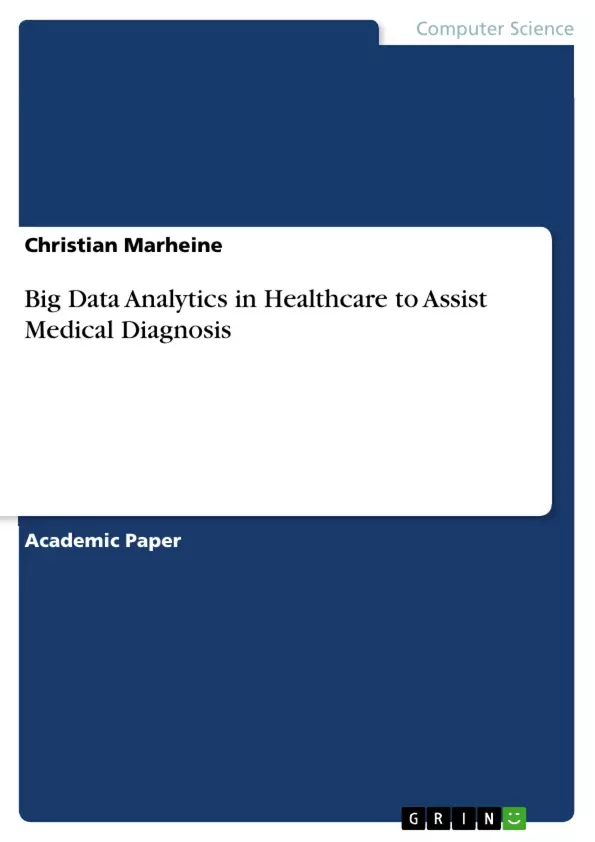This seminar paper discusses how big data analytics might support healthcare organizations (e.g., hospitals) in medical diagnosis. The paper proceeds as follows: First, an overview of big data analytics in healthcare is provided with a focus on medical image analytics. Second, two large-scale image analysis cases are presented to materialize the theory upon which an integrated framework is proposed that illustrates how big data analytics might assist medical diagnosis. Third, the contemporary challenges of IT adoption in healthcare are discussed, and lastly, a brief conclusion is drawn.
Inhaltsverzeichnis (Table of Contents)
- Introduction
- Theoretical Background
- Big Data Analytics in Healthcare
- Image Analytics in Healthcare
- Medical Diagnosis Cases and Proposed Framework
- Discussion
Zielsetzung und Themenschwerpunkte (Objectives and Key Themes)
The paper explores the potential of big data analytics in healthcare, particularly in the field of medical image analysis, to assist in clinical diagnosis. It aims to shed light on innovative data science techniques that can enhance medical decision-making, disease exploration, and ultimately improve patient care.
- The use of big data analytics in healthcare, emphasizing medical image analytics.
- The integration of various data sources, including clinical data, administrative data, and external data.
- The challenges and opportunities associated with IT adoption in healthcare, particularly in the context of big data analytics.
- The development of an integrated framework for leveraging big data analytics to support medical diagnosis.
- The potential impact of big data analytics on clinical decision-making, medical diagnosis, and disease exploration.
Zusammenfassung der Kapitel (Chapter Summaries)
- Introduction: This chapter provides a brief overview of the growing need for big data analytics in healthcare and highlights the challenges and opportunities of utilizing medical image data for improved diagnosis and patient care. It also introduces the research question of how big data analytics can support healthcare organizations in clinical diagnosis.
- Theoretical Background: This section delves into the concept of big data, characterized by its volume, velocity, and variety. It discusses the different types of data sources found in hospitals, including clinical data, administrative data, and external data. The chapter then examines existing architectural frameworks for big data analytics in healthcare, showcasing technologies like Hadoop, Pig, and Hive, and highlighting the challenges of data sharing, integration, analysis, and visualization. The chapter further explores the role of image analytics in healthcare, emphasizing the importance of medical images in diagnosis, therapy assessment, and planning. It discusses the growing volume of medical images, the need for scalable solutions, and the application of advanced methods like support vector machines (SVM), neural networks, and artificial intelligence (AI) in image analysis.
- Medical Diagnosis Cases and Proposed Framework: This chapter presents two case studies that demonstrate the application of big data analytics in medical diagnosis: lung texture classification using Hadoop and MapReduce, and the development of a CAD system to assist physicians in treating traumatic brain injury (TBI) patients. Building upon these cases and the literature review, the chapter proposes an integrated framework that outlines how big data analytics can leverage value creation in healthcare organizations through improved medical diagnosis. The framework emphasizes the importance of shared, integrated data storage, near real-time and accurate data analysis, and powerful yet user-friendly data visualization tools.
Schlüsselwörter (Keywords)
The key terms and focus topics of this paper include big data analytics, healthcare, medical image analytics, computer-aided diagnosis (CAD), decision support systems, medical diagnosis, data integration, data visualization, and IT adoption in healthcare. The paper also addresses the challenges and opportunities associated with data privacy, data governance, and the development of robust and automated medical image analytics solutions.
- Citation du texte
- Christian Marheine (Auteur), 2018, Big Data Analytics in Healthcare to Assist Medical Diagnosis, Munich, GRIN Verlag, https://www.grin.com/document/433121



